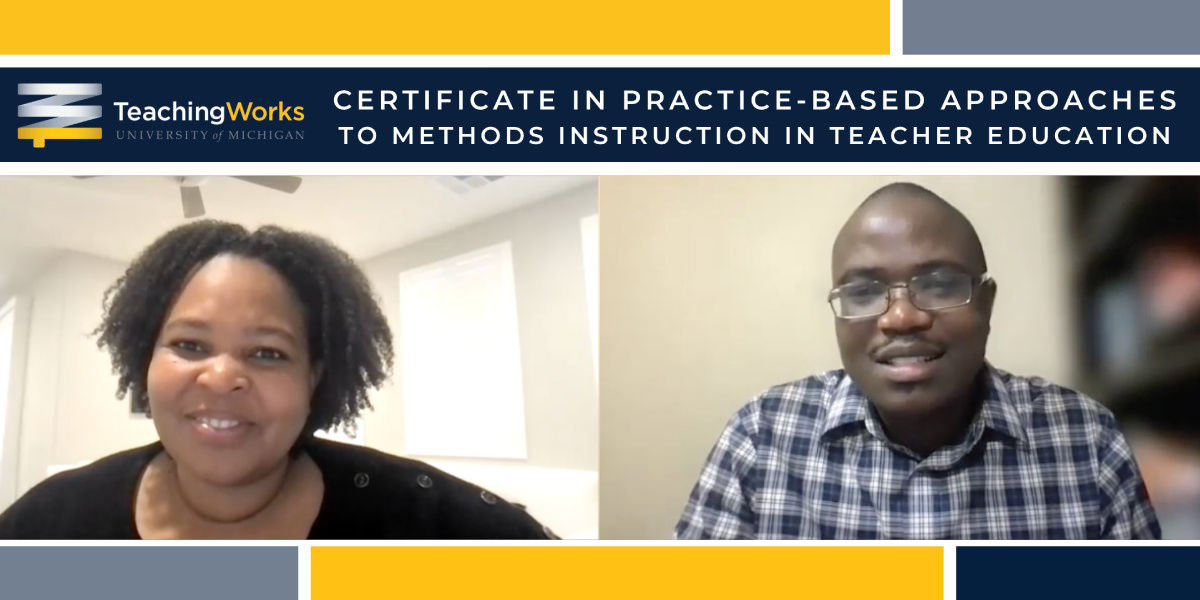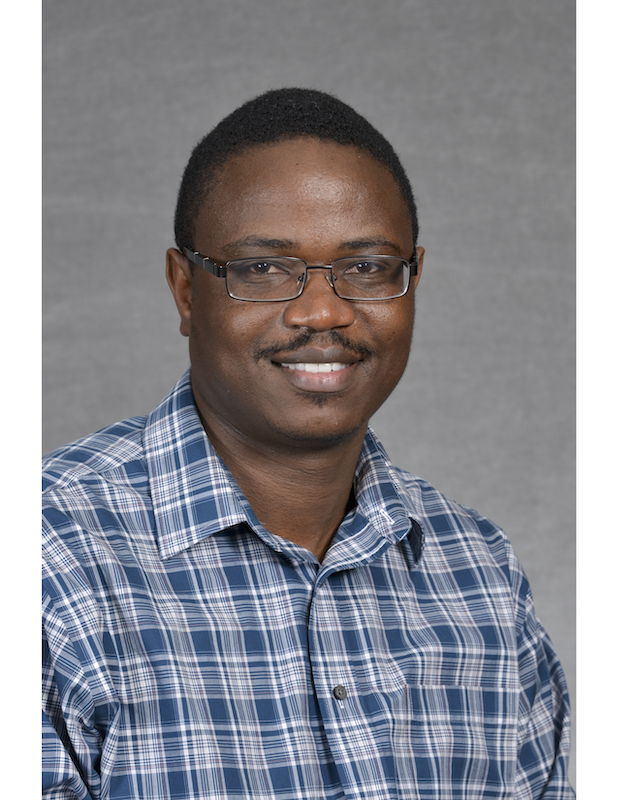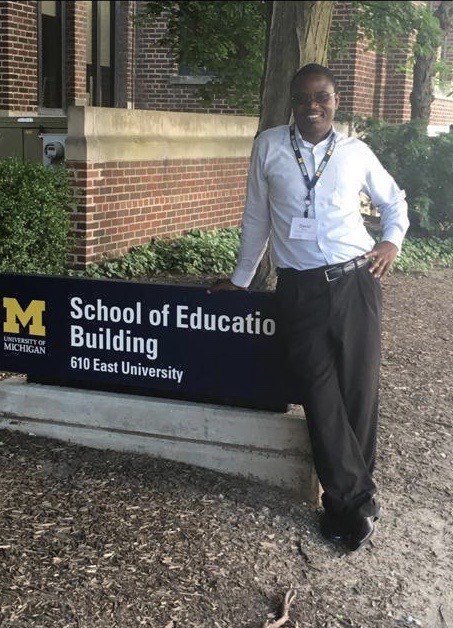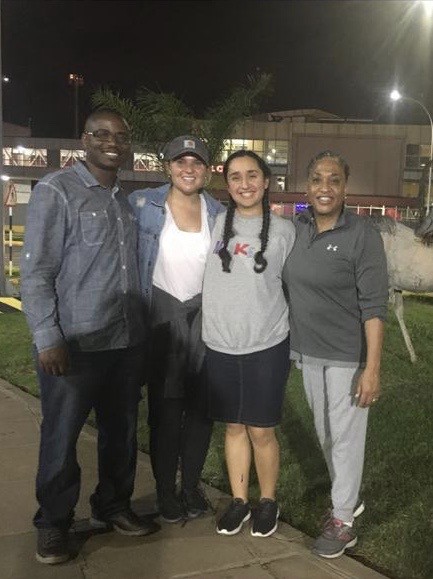Here’s why working with TeachingWorks has been the best use of my time as a junior faculty member at my institution
TeachingWorks Research & Design Specialist Dr. Amber Willis spoke with Minnesota State University, Mankato faculty member Dr. David Kimori about his experiences as a fellow in the TeachingWorks Practice-Based Teacher Education Certificate Learning Sequence.

If you work in higher education, you’re probably familiar with all the responsibilities that can come along with being a junior faculty member: teaching courses, advising and supporting students, doing committee work at the university level, making time for your own writing and research, perfecting your teaching, the list goes on and on.
Given this, it can be a challenge for junior faculty members to pursue professional development opportunities on top of all their usual responsibilities. But for Dr. David Kimori, an Assistant Professor at Minnesota State University (MNSU), Mankato, the challenge is worth it if it means he can hone and refine his practice as a teacher educator.

Meet David, a mathematics and science methods and STEM instructor in the Department of Elementary and Literacy Education at MNSU, Mankato, and one of 29 fellows in the TeachingWorks Practice-Based Teacher Education (PBTE) Certificate Learning Sequence. Launched in July 2020, this 18-month learning sequence supports teacher education content methods course instructors to build facility with practice-based approaches for preparing new teachers that intertwine content knowledge, teaching practice, attending to issues of justice, supporting bilingual students, and delivering culturally responsive instruction.
In addition to earning a certificate in practice-based approaches to methods instruction in teacher education from TeachingWorks, fellows who successfully complete the learning sequence emerge with competence and confidence in preparing new teachers who understand systemic inequity and seek to use their teaching practice to disrupt patterns of injustice in classrooms.
Interested in joining our Practice-Based Teacher Education (PBTE) Certificate Learning Sequence? We’re currently accepting applications on a rolling basis until June 2021! Learn more and access the form to apply here!
“I am appreciative of TeachingWorks because it has been giving me the skills and the support system I need as a junior faculty member,” David said. “I feel like I have the right tools to use in class with my teacher candidates. I don’t have to worry, as a junior faculty member, if I’m doing the wrong stuff and even doubting myself. In higher education, you teach without being given the skills [to teach]. You’re just given a class that you design by yourself. But nobody knows really how and what skills you need to learn. So this is something that you get in TeachingWorks. How do you lead a group discussion? How do you work with teacher candidates? With TeachingWorks, you have an opportunity to see how to enact these practices practically.”
“This is one of those experiences that is actually geared towards teaching. You learn the skills. You learn how to enact a practice. You don’t just learn a practice theoretically.”
TeachingWorks Research & Design Specialist Dr. Amber Willis, who is the co-director of the certificate learning sequence, sat down with David to talk more about his motives for joining the certificate sequence and how his adoption of PBTE has impacted his practice, and his teacher candidates’ experiences and opportunities within his methods courses.
_______
Amber: So before you joined our certificate learning sequence, you participated in our 2019 TeachingWorks Practice-Based Teacher Education Workshop. Talk to me about your experience in that TeachingWorks program. What was it about your introduction to practice-based teacher education that got you excited to enroll in the certificate learning sequence?
David: I participated in the three-day workshop with the practice-based teacher education program before the certificate learning sequence. In particular, during that time, we spent some time talking about leading a group discussion. And we spent time going through the specifics of leading a group discussion. And that’s when I knew I’d been doing group discussions, but I hadn’t been doing it the way [TeachingWorks] proposed. We also had an opportunity to do a coached rehearsal on how we can talk to our teacher candidates in class. So this was really new to me. I had never heard of a coached rehearsal. And from there, I developed an interest in knowing and learning deeper, taking advantage of any opportunities that TeachingWorks was able to provide.

Above all, one of my key takeaways during this time was about advancing justice in the classroom. The phrase that was used during that time was making the invisible students visible in your class. This was so powerful to me, and I felt like I really needed to know more about how I can make invisible students visible in my class. Personally, being a Black male in academia, I have been in situations where people will feel like I’m invisible. I wish I had teachers who made me visible. And I want my teacher candidates to make their students feel visible. These are teacher candidates who are going to be future teachers, who are going to teach my children. So all this really caught me and I thought I wanted to know more. That is how I started to join the certificate program.
Amber: So you were developing an appetite for trying to really figure out how to do this with your teacher candidates. That is amazing. And I love your comment about the advancing justice part about making the invisible visible because that is really important.
So, here’s a tricky question. Being a part of the certificate learning sequence takes a lot of time. It’s an 18-month program, so it’s a significant time commitment, which I’m sure you took into account as a junior faculty member in your institution. Why did you think it was important for you to be a part of this work now at this point in your career?
David: Being a junior faculty member, sometimes you have so many other things that you’re taking care of. But without having the right tools, you end up really struggling a lot in your junior years as an educator. I am appreciative of TeachingWorks because it has been giving me the skills and support system I need as a junior faculty member. So I feel like now I’m doing the right things in class. I have the right tools to use in class with my teacher candidates. I don’t have to worry as a junior faculty member if I’m doing wrong stuff and even doubting myself. I’m getting these skills that have been put together and I’m able to see what my other colleagues are doing and getting a good network of experienced colleagues that we share. With TeachingWorks, we get an opportunity to work with colleagues in the same content area. So you’ll find that the same struggles you have been going through are the same struggles your other colleagues are going through. And you find a solution together so you don’t feel like you’re off track.
So even if it’s time-consuming, this has been very good [for me] as a junior faculty member. And if a lot of learning institutions were supporting junior faculty members by offering such training, I think it’s a good way to propel them in the academic field without much struggle. You know in higher education, you teach without being given the skills. You’re just given a class you design by yourself. But nobody knows really how and what skills you learn to do. So this is something that you get in TeachingWorks. How do you lead a group discussion? How do you work with teacher candidates? And then those skills, you practice them. So this is something that has been very beneficial. I would say it’s the best use of my time.
Amber: As you know, one of our essential features of the certificate learning sequence is for each fellow to develop what we call a practice-based teacher education unit, which is a unit plan of instruction to use in your methods course with your teacher candidates. You are both a science teacher and a math instructor. Yet you’ve chosen to develop your unit in science. Why did you decide to focus more on science than on math? Is there a particular reason for that?
David: One of my colleagues, Dr. Karen Colum, is also in the certificate learning sequence. And we teach together in math methods. So because we were enacting this practice together in math, I decided to focus on science so that the teacher candidates will see it in math and then have an opportunity to do it in science. But, I’ve also realized that when I’m doing eliciting and interpreting student thinking, the questions you can pose in math are not the same questions that you can pose in science. We have come to realize that in science, the students really need to dig deeper and get to know the content so that they can develop good questions that can elicit students’ thinking just like in math. We wanted to give our teacher candidates a broad opportunity to see the high-leverage practices in both science and math.
“How can you incorporate advancing justice in this context of germs and viruses in science? When I had this in mind, I had my students talk about the spread of germs and the coronavirus and how the coronavirus pandemic affected people of color proportionately at higher numbers. We even talked about why marginalized groups are exposed to germs and diseases.”
Amber: And have you and your colleague had a chance to come together and think about the work that you’re doing collectively with the same teacher candidates?
David: Yes, we talk. Right now, the high-leverage practice my colleague is doing is leading a group discussion and I’m doing eliciting and interpreting student thinking. We chose that strategically. And the good thing is, sometimes she mentions things like, “My teacher candidates, they have difficulties in this.” And I also say, “I also experienced this, but then I tried this and it worked well.” So we compare notes.
Amber: It’s nice to have a colleague who’s also doing this work with you so that you can both try different things out and have thought partners inside of your program. So what has developing your unit been like?
David: This time around with developing my unit, I am doing it with a lot of consciousness of the things that I’ve learned from TeachingWorks. For example, the first unit that I developed was about germs and viruses in science class. And we were relating that with the coronavirus pandemic. How can you incorporate advancing justice in this context of germs and viruses in science? When I had this in mind, I had my students talk about the spread of germs and the coronavirus and how the coronavirus pandemic affected people of color proportionately at higher numbers. We even talked about why marginalized groups are exposed to germs and diseases.
So in developing my units and the lessons now after getting exposure from TeachingWorks, whenever I’m teaching or I’m planning a lesson, I am very conscious of the specific elements that I want my students to achieve and the specific practices that I want them to know. Like for coming up with and posing good questions to elicit students’ thinking or interpret students’ thinking. Now I will ask, “At what point in my lesson am I having my teacher candidates have an opportunity to develop and pose questions for interpreting a student’s thinking?”
Amber: Think back to last semester when you were developing that first practice-based teacher education unit. You were trying to introduce the practice of eliciting and interpreting student thinking in science. You were thinking about germs and viruses, while also layering in these ideas around how to advance justice and disrupt inequities when it comes to thinking about germs and viruses. Did you have any exciting or “aha” moments while you were trying to put all these pieces together?
David: I think one of my exciting moments was when I was enacting this practice of eliciting and interpreting student thinking. I enacted a coached rehearsal with my teacher candidates on the practice. I was acting as a student and one of my teacher candidates was acting as my teacher and the other students were watching. Then we reversed the roles so I was the teacher and then I had a teacher candidate also being my student. And then the whole class gave us feedback afterward. And this was done after I introduced the whole practice. I was excited to see my students giving feedback like, “So when you are asking these questions, you could have provided an opportunity for the students to communicate in another way.” Or, “What was another way you could have presented the same question?” Or, “Instead of asking this question this way, you could have done this.” So the “aha” moment was when my students were giving feedback as professionals, they were able to use the language that I had already introduced to them. So sometimes students can learn very well by providing feedback and critiquing an episode of teaching like we had.
This has now carried over especially in my science class. Every week students are presenting discrepant events for fifteen minutes. At least one student does that and teaches an inquiry-based lesson. And then after teaching, the whole class has an opportunity to give feedback. And you can hear from the feedback all the different questions they have like, “What are some of the questions that you have in mind that can help the students understand this concept?” Or, “How can you really promote justice with this list of questions?” Hearing their questions and feedback is one of my exciting moments.
“Sometimes teacher candidates don’t have the patience for listening. Whenever a student seems like they are struggling, teacher candidates feel empathy for them and fill in very quickly with giving answers. So giving them enough thinking time is something that I thought I should spend time teaching them. It’s ok whenever you see a student struggling. That productive struggle is ok.”
Amber: So it sounds like, through these practice-based pedagogies that you’re using to give them an opportunity to practice eliciting and interpreting student thinking, you’re seeing in your teacher candidates’ reflections and their observations that they’re using this shared professional language. They’re pushing back and they’re helping their colleagues and their peers build good questions and ideas.
Last semester, you developed and implemented your first unit and it was on eliciting and interpreting student thinking. You decided this semester that you were going to do the same high-leverage practice of eliciting and interpreting student thinking. What did you learn last semester when you implemented your unit with teacher candidates? And how are you thinking about revising your unit this semester based on what you learned last semester when you tried it out for the first time?
David: When I tried it the first time, one thing I learned is that if you don’t make a deliberate effort for the students to come up with the questions they will pose to elicit student thinking, it becomes a challenge. They have to spend time coming up with good questions to elicit student thinking. But most importantly, what I learned about is the listening piece. Sometimes teacher candidates don’t have the patience for listening. Whenever a student seems like they are struggling, teacher candidates feel empathy for them and fill in very quickly with giving answers. So giving them enough thinking time is something that I thought I should spend time teaching them. It’s ok whenever you see a student struggling. That productive struggle is ok. They’re learning, it’s not so frustrating. So just learn that skill of listening. So that is something that I learned, and I’m looking forward to now to revise and work on more. How can they develop that patience of giving the students enough thinking time during this practice?

And at the same time, how can they make sense and interpret students’ thinking based on what the students are saying? If any of the students are not necessarily using the same academic language they want, or all the students are not expressing in the same language the teacher wants, how can they have the patience to make sense of what the students are saying without necessarily making the students feel like they’re not saying it correctly? And what questions could they pose to enable the students to think about the idea they are saying, present the same idea, but then get helping questions that break down the ideas for them? These are some of the things I’m looking forward to changing.
Amber: Now, I know you’re in the final stages of getting your unit for this semester just right to go out and implement it in a couple of weeks. Can you give us a sneak peek and tell us a little bit about what content you are using in this new unit for this semester?
David: The content I’m focusing on this semester in my unit is the states of matter. So the students are going to see the different states of matter, solids, liquids, and gases. But more so, how can they use representations to teach elementary children about the states of matter? I’m going to give an opportunity to my teacher candidates to come up with questions to ask that will help the students learn more about the states of matter and what differentiates solids from liquids, from gases. Once they develop the questions, I will also have a rehearsal. We will do small group rehearsals, and then we will do a whole class rehearsal. So I will be helping them focus on specific teaching moves and on the feedback that I am going to give during the rehearsal.
Amber: I’m excited to see how the lesson turns out. I know that doing rehearsals may be a little new for you, but I think you’re going to do great. And, I think your students are going to feel really rewarded getting the opportunity to practice this work in the methods class before they go out to the classroom. Is there anything that you want to share with others who might be interested in joining the certificate learning sequence?
David: Well, I think it’s a good opportunity. It’s been good learning from other colleagues, sharing and having time to practice together, and working together. This is one of those experiences that is actually geared towards teaching. You learn the skills. You learn how to enact a practice. You don’t just learn a practice theoretically. For the most part, my learning has been just learning about these teaching practices theoretically, and then I figure out on my own how to enact them in class. But with TeachingWorks, you have an opportunity to see how to enact these practices practically. And you get to learn from colleagues who have been doing them over time. It’s a good place to be. I appreciate the opportunity to work with TeachingWorks, and I’m looking forward to learning more.
This interview has been edited and condensed for clarity.
Explore the Resources in this Article in the TeachingWorks Resource Library
The TeachingWorks Resource Library is our free, online repository of practice-based teacher education curriculum materials.
- You can learn about more the high-leverage practice eliciting and interpreting students’ thinking here. Teachers pose questions that create space for students to share their thinking about specific academic content. They seek to understand student thinking, including novel points of view, new ideas, ways of thinking, or alternative conceptions. Teachers draw out student thinking through carefully chosen questions and tasks and attend closely to what students do and say.
- You can learn about eliciting and interpreting students’ thinking in science here. Teachers elicit students’ thinking to gain insight into their students’ scientific beliefs and to prepare them to engage in scientific practices. Students have many alternative ideas about scientific phenomena; by eliciting students’ ideas, teachers learn how to design instruction to respond to and build on those ideas. When teachers prompt students to share their thinking about science content or other students’ ideas, students develop the skills they need to make scientific arguments.
- You can learn more about the practice-based teacher education pedagogy of rehearsal here. A coached rehearsal is a live simulation of an episode of teaching led by a more expert guide. One novice teacher at a time acts as the teacher while the teacher educator facilitates and coaches. Other novice teachers may play P12 students or act as observers. Coaching involves not only offering directive feedback, but also surfacing decision points and problems of practice as they arise, inviting the group to collaboratively consider them.
Credits
Writers: Alyssa La’Dawn Brandon, TeachingWorks Communications Coordinator; Dr. Amber Willis, TeachingWorks Research & Design Specialist
Producers: Alyssa La’Dawn Brandon, TeachingWorks Communications Coordinator; Gloria Li, TeachingWorks Graphic Designer
Thanks toAtwillis and David Kimori
